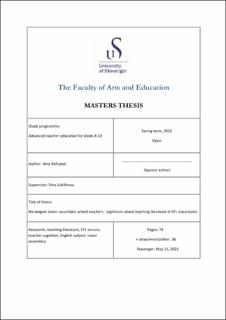| dc.description.abstract | For this master’s thesis, the researcher conducted a mixed methods study concerning the teaching of literature in Norwegian lower secondary English as a foreign language (EFL) classrooms. The focus of this study is on Norwegian lower secondary teachers’ cognitions about teaching literature in the EFL classroom. Teacher cognitions, meaning what teachers think, know, and believe in conjunction with literature teaching, are thus important. With an aim of understanding the relationship between teacher cognitions and literature teaching, the study addresses three research questions. The research questions are related to how Norwegian lower secondary teachers approach teaching literature in EFL classrooms, what literary texts and genres the teachers choose for their EFL classrooms, and why the teachers teach literature in their EFL classrooms.
To collect data for this research, a mixed methods research design was employed. Specifically, 209 Norwegian lower secondary EFL teachers answered an online questionnaire before the researcher conducted follow-up interviews with five teachers. The questionnaire gathered a number of text titles and different characteristics about what texts were taught, while the interviews provided an understanding of what was taught and why. With a sustainable data collection of information regarding the teaching of literature, the theoretical orientation helped interpret the findings. Well-known reading theories, such as Krashen’s (1997) extensive reading, together with three models for the teaching and learning of literature (Carter and Long 1991), helped the researcher reach an understanding of why these teachers teach the way they do.
Regarding the first research question, the teachers approach teaching literature by being willing to involve the students in the decisions made, but due to different limitations, this is not possible on a regular basis. Ultimately, the teacher-centred model for choosing texts for Norwegian lower secondary EFL classrooms is the most frequently used despite teachers preferring the student-centred model. Nonetheless, the teachers are future-oriented, turning towards the internet as their primary source of literary texts. Hence, the internet is challenging the textbook as the most frequently used source where Norwegian lower secondary EFL teachers find texts for classroom use.
The second research question investigates what texts and genres are taught in Norwegian lower secondary EFL classrooms. The findings reveal that the literary texts taught in Norwegian lower secondary EFL classrooms have some common characteristics. For example, they are often written by male authors from Britain or the USA, they are often in categories aimed at young people’s interests (namely young adult novels and fantasy novels), and they are often written in the 20th or 21st century. Some books and some authors are also more frequently used than others. Thus, The Absolutely True Diary of a Part-Time Indian by Sherman Alexie and texts by Roald Dahl dominated as literary text taught in Norwegian lower secondary EFL classrooms. Based on the interviews, these texts, among others, are more popular than others due to the themes they contain. In other words, the themes that are relevant to the lives of young people are the most common ones.
The third research question investigates why the EFL teachers teach literature, hence, the reasons why themes that are relevant to the lives of young people are important. The themes are analyzed in relation to the cultural model, the language model, and the personal growth model. The teachers considered the understanding of cultures different from the students’ own culture, development of proper language, and development of self-awareness in the student as some of the most important reasons why they teach literature. These findings explain why the teachers approach teaching literature with a willingness to have students involved in the decisions made and why texts relevant to the students’ interests and lives are chosen. Nevertheless, a clear answer to why Norwegian lower secondary teachers teach literature in EFL classrooms was not discovered in this research.
There has been little similar research at the Norwegian lower secondary level in the EFL context. Hence, the findings of this study could be relevant for Norwegian lower secondary teachers. For instance, the list of literary texts frequently taught in Norwegian lower secondary EFL classrooms (see Table 4) might help teachers choose texts valued as relevant for young people and be in line with the curriculum. In addition to The Absolutely True Diary of a Part-Time Indian by Sherman Alexie, Harry Potter by J. K. Rowling, Wonder by R. J. Palacio, and The Hunger Games by Suzanne Collins are texts relevant for young people and in line with the curriculum. Additionally, teachers value models and theories that highlight students’ interests and participation in the learning of literature because they feel that this makes the students more interested in learning about literature. This finding, together with the list provided in Table 4, might help teachers create their reading lists and understand why a text may or may not be a good choice for the Norwegian lower secondary EFL classroom. | |
